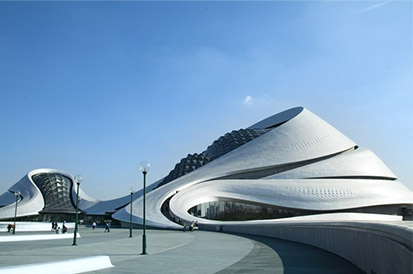New business card of Ice City
As November arrives, the southern region continues to bask in warm sunlight while Harbin, the ice city, welcomes its first snowfall. This captivating destination attracts visitors from across the country to witness its enchanting northern scenery of “endless miles of ice and snow”... For Harbin, a city steeped in rich history and culture, must-see attractions include the Ice and Snow World, Central Street, Sophia Church, Snow Village, and Yabuli Ski Resort. These traditional and iconic landmarks offer an opportunity to fully immerse oneself in snowy delights... On the northern bank of the Songhua River stands a unique and exquisite architectural masterpiece that adds a new dimension to this icy metropolis-----the Harbin Grand Theater, an unmissable symbol representing the city's vibrant spirit.

The Harbin Grand Theatre, situated on the northern bank of the Songhua River and linked to Harbin Cultural Island by a bridge, draws inspiration from the natural scenery of its surrounding wetlands and frozen North features. Breaking free from the ice-bound wetlands, it rises up as an extension of nature itself, becoming one with the vast white horizon that stretches out before it. Its undulating form resembles a floating silk ribbon or snow-capped mountain peak, imbued with all the grace and agility of a spirit dancing along the banks of the Songhua River. This stunning edifice boasts both beauty in its curves and power in its presence - truly deserving of its status as a landmark building in Harbin.
The curvy exterior of the Harbin Grand Theatre is made of smooth white aluminum alloy decorative panels. As you approach the building, there are also some undulating designs such as small bags on its surface. "Observing these arranged skins on the structure evokes a sense of witnessing living tissue, imbuing the metallic edifice with an essence of respiration." This architectural landmark serves as an exemplary representation of Harbin's distinctive urban character, showcasing its ruggedness, grandeur, and vibrant northern artistry. Simultaneously, the building seamlessly integrates with its picturesque natural surroundings, forming an organic entity that epitomizes Harbin's unique urban landscape.
The Harbin Grand Theatre stands as an iconic architectural masterpiece, with its snow-covered scenery becoming a renowned landmark landscape. Illuminated by night, the line design seamlessly blends together, blurring the distinction between real and artificial snow, creating a truly magnificent spectacle. The lighting designer took into account the grand theatre's exterior design to achieve optimal results. The pristine white facade of the Harbin Grand Theatre not only mirrors the surrounding snowy vistas but also interacts harmoniously with its interior decor. Stepping inside this theatre is akin to entering a realm of ice and snow, where an enchanting interplay of lights unfolds.
Excellent cladding system
The Harbin Grand Theatre boasts a distinctive architectural art style, featuring a unique and intricate structural design with large spans, high ceilings, and complex steel elements. Its three-dimensional curved surface modeling sets new standards in the field, incorporating pioneering design and construction elements that fill numerous technical gaps in domestic theater construction. This project presents an excellent level of difficulty and technological complexity both within the country and globally.
The metal roof of Harbin Grand Theatre spans over 18,600m²and boasts a complex design. In response to the project's unique characteristics, Hoogovens collaborated with MAD Architects and other stakeholders to collectively explore product selection, technical solutions, and treatment methods for both the metal roof and curtain wall.
Finally, it has been determined that the inner layer of the roof will utilize Hoogovens ®65/400 straight panels, tapered panels, tapered-convex curved panels, and other panel types. Additionally, the outer layer will consist of aluminum alloy decorative panels. Furthermore, a comprehensive design approach is employed to ensure technical requirements and functional use are met while also achieving an aesthetically pleasing appearance for the building.
Designers use 3D modeling software to fine-tune the building model, ensuring seamless integration between the main steel structure and the curtain wall. Additionally, they take into account roof distortion characteristics to identify the most cost-effective and optimal approach for adapting to the surface of panel arrangement combinations, ultimately achieving a flawless closure and aesthetic appeal for the roof.

Designed by Ma Yansong (Zaha’s disciple), founder of MAD Architects, Harbin Grand Theatre showcases the breathtaking beauty of architecture that rivals even the world-renowned Sydney Opera House in Australia. In 2015, it was awarded Best Building of the Year by Arch Daily, a prestigious architectural news website. As China's only award-winning building, it was recognized as the Best Cultural Building.
It took six years from the initial design phase to its completion, during which time it garnered significant attention from the international media. Following its completion, it immediately elicited strong reactions and graced the covers of prestigious architectural and design magazines such as Architectural Record (cover), Abitare (cover), and MARK (cover). The renowned American publication "Architectural Record" praised the building's "captivating curvature," while Dutch magazine MARK acclaimed how it seamlessly integrates with the natural environment, harmoniously becoming a part of Earth's landscape.
MAD has gone beyond the traditional theatre building genre by creating a structure that draws inspiration from nature and pays tribute to the local character, culture, and arts. The Harbin Grand Theater strengthens the emotional connection between the public and their surroundings, ultimately shaping not only the performance space but also redefining theatre within its natural context. It has become a remarkable new landmark for the city.
PS: Some of the material in this article comes from the Internet